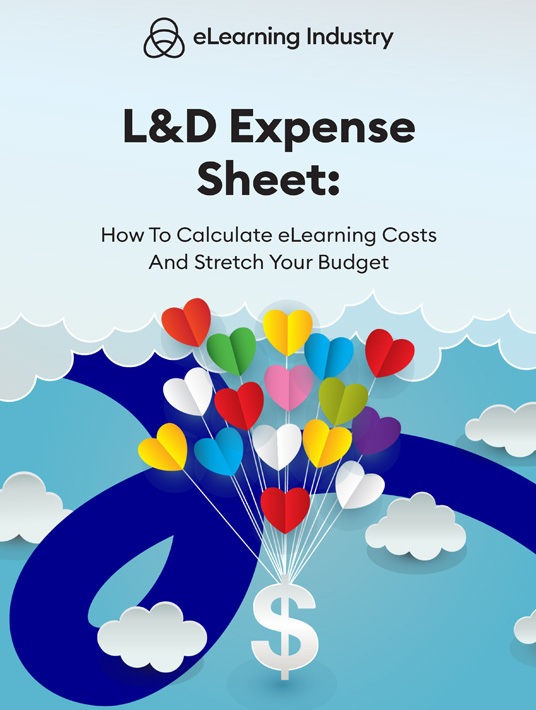How Much Does Online Training Development Cost?
Online learning can bring numerous benefits to your business. It helps your employees acquire new skills and develop professionally, thus increasing engagement and retention. However, creating an online course is a multifaceted project, so you need to be well-prepared. Specifically, it’s important to know the various online training development costs involved in the process. This way, you can prepare a comprehensive expense sheet that allows you to create a course that covers your training needs and increases ROI.

6 Development Expenses To Keep In Mind
1. Essential Software
A crucial factor that affects online training development costs is choosing the right Learning Management System. The LMS is your primary tool for developing and then delivering your course, as well as tracking learner progress and issuing certificates. You can find LMSs at various price points that reflect the complexity of their features. Your specific training needs are going to largely affect the budget allocated towards this purpose. But keep in mind that you shouldn’t be calculating only the initial purchase and installation fees. There are also fees for upgrades, storage, and sometimes even support comes at a price. Make sure to consider all these elements to avoid unpleasant surprises.
2. Additional Equipment
If you are considering creating the training content in-house, you need to add equipment costs to your budget. For example, if you are creating videos or webinars, you’re going to need a high-quality video camera, a microphone, and maybe a lighting kit. Video editing software would also be very useful to give your content a professional polish. Don’t forget a fast internet connection to keep processes flowing easily.
3. Staff Training
The best software and authoring tools in the market won’t do you much good if your team doesn’t know how to use them. Therefore, you must factor in the time it will take for your eLearning development team to acquire the technical know-how that will allow them to bring in maximum results. Then they will be able to create professional-looking and well-organized content that accomplishes your training goals. You can start this process by assessing their skills and knowledge gaps. Once you have a clear picture, you’ll know what steps you need to take to address these gaps and add the associated costs to your budget.
4. Content Development Process
As you can imagine, this is the most crucial online training development cost. And yet, it is often miscalculated, causing many courses to never actually reach completion. The development process can take two possible courses. You can either develop it in-house or outsource the project to a third-party course creator. The first route calls for a capable eLearning development team. This is the time to crunch down the cost of training employees or bringing onboard new ones to take over essential roles, such as that of the Instructional Designer. The outsourcing route still requires time for the selection process but will give you faster access to experienced subject matter experts. Just remember to determine all initial and additional fees before you hire any vendor.
5. Course Completion Time
Something that many seem to forget is that content creation is a process that takes time. And time is an eLearning development cost that needs to be accounted for in the budget! Not all courses are equal, which means that they don’t all take the same amount of time to be completed. Primarily, their complexity is what determines the timeline. Specifically, there are 4 levels of course complexity that determine how interactive and multimedia-heavy they are. The higher the level, the longer it takes to complete.
- Level 1: Passive eLearning
This type of course requires no interaction. It presents information in a simple form, such as text, audio, or simple video, and includes quizzes with multiple-choice and true-false questions. It focuses on delivering information and includes no games or simulations.
- Level 2: Limited Participation eLearning
These courses make use of interactive media such as animations and basic drag-and-drop functions. It blends theory and practice to boost knowledge retention and keep learners engaged.
- Level 3: Moderate Interaction eLearning
Here, we’re entering personalized learning territory with occasional simulations, detailed branch scenarios, and complex drag-and-drop functions. It focuses more on developing new skills through practice than theory.
- Level 4: Full Immersion eLearning
In this course, learners are expected to constantly interact with content in order to progress. It includes serious games, simulations, interactive games, customized multimedia, and more. It aims to simulate on-the-job training and it is the most expensive to create.
6. Upkeep
If you think that content creation ends when the course rolls out, you’re in for a big surprise. In reality, this is a continuous process that needs to be developed constantly to improve the learning experience and increase ROI. Content needs to be checked and updated frequently so that it remains relevant. In addition, your software will require updates and upgrades from time to time. Not to mention the technical issues that any eLearning business can expect. Therefore, it’s important that you plan for these costs and extend your budget to include more than the initial development fees.
Planning Ahead
No matter how well you plan, you can always expect some unpredicted costs to pop up. Your team could make a mistake or miss a deadline, or the domain you were thinking of buying to register your website is more expensive than you thought. In any case, online courses can change the way your business operates and significantly increase ROI. All you have to do is be thorough when calculating online training development costs for your expense sheet. Hopefully, the pointers we shared in this article have simplified the process for you and given you the confidence to make this investment.
Download our eBook L&D Expense Sheet: How To Calculate eLearning Costs And Stretch Your Budget to maximize your resources.

